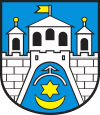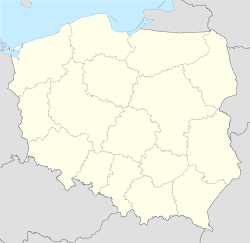- Ostrowiec Świętokrzyski
-
Ostrowiec Świętokrzyski Saint Michael's Church 
Coat of armsCoordinates: 50°56′N 21°24′E / 50.933°N 21.4°E Country  Poland
PolandVoivodeship Świętokrzyskie County Ostrowiec Gmina Ostrowiec Świętokrzyski (urban gmina) Government – Mayor Jarosław Wilczyński Area – Total 46.43 km2 (17.9 sq mi) Population (2006) – Total 73,937 – Density 1,592.4/km2 (4,124.4/sq mi) Time zone CET (UTC+1) – Summer (DST) CEST (UTC+2) Postal code 27-400 Car plates TOS Website http://www.um.ostrowiec.pl Ostrowiec Świętokrzyski Polish pronunciation: [ɔsˈtrɔvʲɛt͡s ɕfʲɛntɔˈkʂɨskʲi] (
 listen) is a town in south-central Poland with 74,211 inhabitants (2006). Main industry is metallurgy. Ostrowiec is the capital city of Ostrowiec Świętokrzyski County, part of Świętokrzyskie Voivodeship (since 1999), previously it belonged to Kielce Voivodeship (1975-1998).
listen) is a town in south-central Poland with 74,211 inhabitants (2006). Main industry is metallurgy. Ostrowiec is the capital city of Ostrowiec Świętokrzyski County, part of Świętokrzyskie Voivodeship (since 1999), previously it belonged to Kielce Voivodeship (1975-1998).Contents
History
The oldest testimonies of human habitation date back to the Stone Age (ca 4000 BC). In that time, there were nomadic tribes belonging among others to Lengyel and Globular Amphora cultures. They came here from Danube river region.
The earliest documents about Ostrowiec village, that gave beginning to the contemporary Ostrowiec Świętokrzyski, come from 14th century. The city itself was built from scratch in 1597 by Jakub Gawroński of Rawa coat of arms on the left bank of the Kamienna river, situated in the Vistula river basin. It received town privileges in 1613. It became a property of Janusz Ostrogski, a statesman and one of the richest magnates of the Polish–Lithuanian Commonwealth. Later it belonged to many Polish aristocratic families: Tarnowski family, Czartoryski family, Lubomirski family, Radziwiłł family, Zasławski family, Sanguszko family, Wielopolski family, Dobrzański family, Łubieński family. After the 2nd WW it was confiscated and became a property of the state.
In 19th c. metallurgical industry developed. Steel plant of Ostrowiec was second big in the whole of Congress Poland in 19th/20th centuries. During Revolution of 1905 Ostrowiec was a place of massive demonstrations and industrial action.
During the 2nd World War, Ostrowiec was a lively centre of resistance activity against the Nazi German occupation. There was an underground weapon production, independent underground press etc. Jewish population was forced to live in a local ghetto, ca 11 thousand Jews were murdered by the Nazi in 1943-1944.
In 1990-ties metallurgical industry experienced a big crisis. The steel plant was bought then by Spanish CELSA Group.
Culture
Inhabitants of Ostrowiec are known to be involved in many culture and arts activities. The town has a variety of cultural institutions including:
- Municipal Cultural Centre
- Office of Artistic Exhibitions
- The Museum of History and Anthropology with the forest reserve in Krzemionki
- Public Library- has locations in different parts of the town
- Houses of Culture - children can get involved in the dance classes, drama classes, classes of art and modelling etc., literature and general knowledge competitions are also organized.
Ostrowiec Świętokrzyski also boasts a Musical School and the State Artistic Centre, both of which have had an important influence upon the cultural development of the town.
Education
- Wyższa Szkoła Biznesu i Przedsiębiorczości
- Catholic High School HTTP://www.klo.ostrowiec.pl
Sports
- KSZO Ostrowiec Świętokrzyski - football team (1st league 2009/2010)
International relations
Twin towns — Sister cities
Ostrowiec Świętokrzyski is twinned with the following cities:
 , Pineto, Italy
, Pineto, Italy , Bekabad, Uzbekistan
, Bekabad, Uzbekistan
External links
Seat: Ostrowiec Świętokrzyski (urban gmina)Urban-rural gminas 
Rural gminas Categories:- Cities and towns in Świętokrzyskie Voivodeship
- Ostrowiec County
Wikimedia Foundation. 2010.


